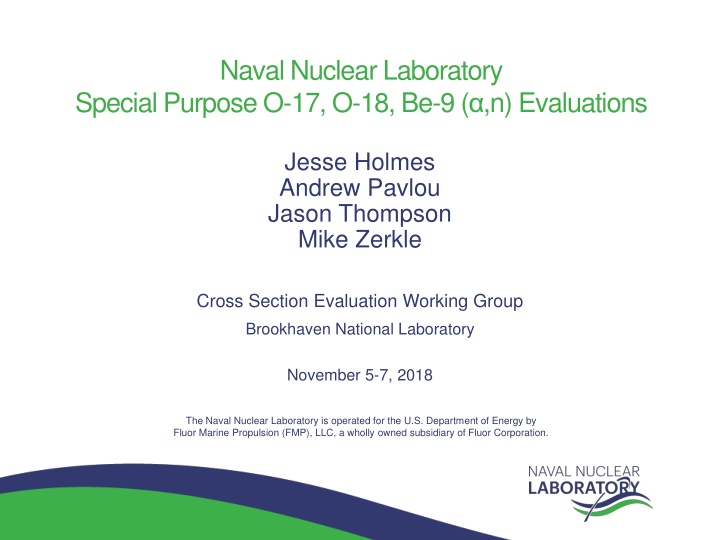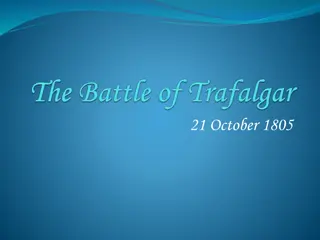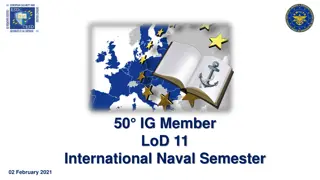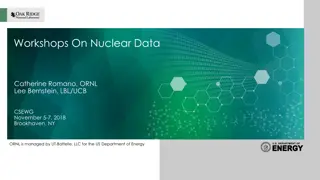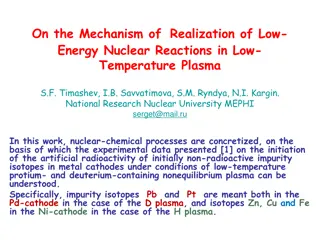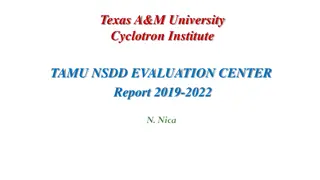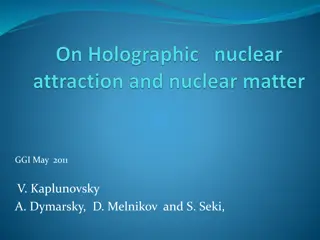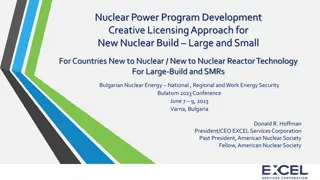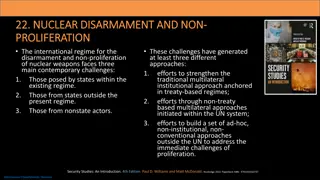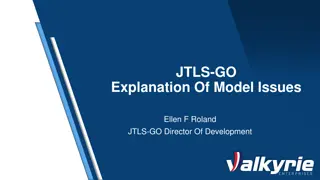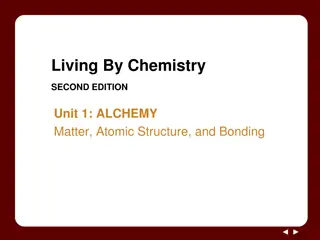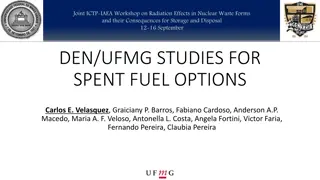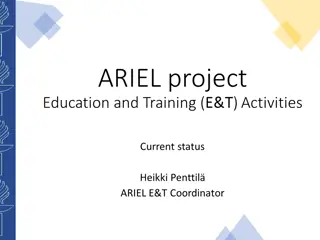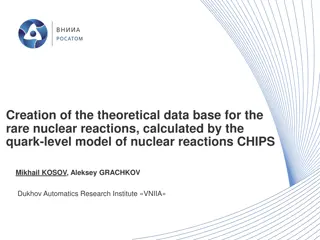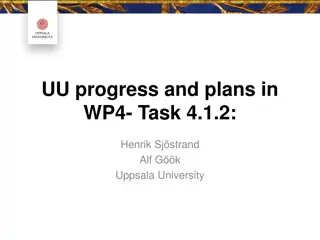Naval Nuclear Laboratory Special Purposes: O-17, O-18, Be-9 Evaluations
The Naval Nuclear Laboratory specializes in special purpose evaluations involving O-17, O-18, and Be-9. The evaluations focus on neutron production, source characterization, neutron yield calculations, and testing of JENDL/AN-2005 data. The laboratory addresses deficiencies in neutron energy spectra and modifies evaluations for inclusion in ENDF/B-VIII.1. Explore the applications for special purpose (.,n) libraries and the testing of JENDL/AN-2005 (.,n) evaluations. See the results of natural uranium UO2 (.,n) neutron spectra JENDL library testing and learn about the Kalbach-Mann systematics used for O-17 and O-18. Discover the methodologies and advancements in evaluating neutron properties for various materials and reactions in nuclear environments.
Download Presentation

Please find below an Image/Link to download the presentation.
The content on the website is provided AS IS for your information and personal use only. It may not be sold, licensed, or shared on other websites without obtaining consent from the author.If you encounter any issues during the download, it is possible that the publisher has removed the file from their server.
You are allowed to download the files provided on this website for personal or commercial use, subject to the condition that they are used lawfully. All files are the property of their respective owners.
The content on the website is provided AS IS for your information and personal use only. It may not be sold, licensed, or shared on other websites without obtaining consent from the author.
E N D
Presentation Transcript
Naval Nuclear Laboratory Special Purpose O-17, O-18, Be-9 ( ,n) Evaluations Jesse Holmes Andrew Pavlou Jason Thompson Mike Zerkle Cross Section Evaluation Working Group Brookhaven National Laboratory November 5-7, 2018 The Naval Nuclear Laboratory is operated for the U.S. Department of Energy by Fluor Marine Propulsion (FMP), LLC, a wholly owned subsidiary of Fluor Corporation.
Applications for Special Purpose (,n) Libraries Calculation of yield and spectrum of neutrons produced by ( ,n) reactions with light nuclides in materials containing actinide -particle emitters. Non-fission neutron source characterization for reactor analysis, Am-Be / Pu-Be sources and shielding, nuclear safeguards, materials non-destructive assay, etc. JENDL/AN-2005 includes ENDF-6 format ( ,n) evaluations for 17 nuclides with Z 14. No ( ,n) evaluations are available in ENDF/B. The LANL code SOURCES is considered an industry standard for ( ,n) neutron source characterization. NNL recently implemented an in-line ( ,n) source sampling methodology in MC21 for Monte Carlo radiation transport simulations. The LLNL Monte Carlo code COG uses a similar approach, but only the ability to calculate neutron yields has been studied. Other Monte Carlo codes exist that use various methods enabling ( ,n) calculations (MCNP, FLUKA, GEANT, SRIM/TRIM, etc.) but suffer from a variety of disadvantages (transport expense, manual input requirements, geometry limitations, etc.). 2
Testing JENDL/AN-2005 (,n) Evaluations NNL tested the JENDL/AN-2005 ( ,n) evaluations in MC21. Calculated neutron yields and energy/angle spectra were compared to available experimentally measured data from public literature. MC21 neutron yield results compared very well with most experimental data. For neutron energy spectra, MC21 results were noted to deviate significantly from published experimental data for naturalUO2, 238PuO2, and Am-Be sources. The deviations were determined to be caused by physics deficiencies in the JENDL/AN- 2005 evaluations for O-17, O-18, and Be-9. NNL modified these evaluations to address the identified deficiencies and validated the new versions against experimental data. NNL is now submitting these modified special-purpose ( ,n) evaluations for inclusion in ENDF/B-VIII.1. 3
Natural-Uranium UO2 (,n) Neutron Spectra JENDL Library Testing for O-17,18 4
Problems with Kalbach-Mann Systematics O-17 and O-18 use Kalbach-Mann systematics for File 6 coupled energy/angle distributions for MT=4 (production of one neutron in the exit channel). Energy/angle distributions based on Kalbach-Mann systematics are decoupled from the partial cross sections for reactions leaving the residual in the ground state or particular low-level excited states. The Q-values of low-level nth excited-state reactions (including the 0th ground- state) are widely separated and strongly impact the emitted neutron energy spectrum for reactions induced by low-energy particles. Kalbach-Mann theory for ( ,n) neutron energy/angle distributions is appropriate for very-high-energy incident particles (tens to hundreds of MeV), where high- level residual excited states (or a continuum excited state) dominate. Not appropriate for low-energy particles emitted by actinide decay (approx. 4-7 MeV), which will then undergo slowing down in materials of interest. 6
File 6 Neutron Energy/Angle Modifications for O-17,18 (File 3 cross sections are unchanged) MT 4 Reaction ( ,n) Description Production of one neutron in the exit channel. Sum of MT=50-91. Production of two neutrons and a residual. Production of a neutron and an particle, plus a residual. Production of a neutron and a proton, plus a residual. Production of a neutron, with the residual in the 0th-40th excited state. Production of a neutron in the continuum not included in the above discrete representation. Total neutron production. 16 22 28 50-90 ( ,2n) ( ,n ) ( ,np) ( ,n0-40) ( ,nc) 91 201 ( ,Xn) Nuclide Cross Section MF3 MTs JENDL version MF6 MTs NNL version MF6 MTs O17 4 22 50-53 91 201 4 16 22 50-54 91 201 4 22 22 50-53 91 O18 4 16 22 16 22 50-54 91 Color-coded MT values indicate neutron energy/angle distribution treatment Green: Kalbach-Mann coupled energy/angle distribution Red: Isotropic two-body kinematics 7
Natural-Uranium UO2 (,n) Neutron Spectra JENDL vs. NNL Library Performance for O-17,18 8
Be-9 Breakup Reaction 9Be( , )9Be* 8Be+n (included in MT=22) JENDL uses Gibbons (1965) to fit MT=201 total XSs. Then, MT=22 is calculated based on Obst (1972). Van der Zwan and Geiger (1970) is used for MT=50-52,91 ratios, but not for normalization. MT=4 (MT=50-52+91) is calculated by subtracting MT=22 from MT=201. 11
Be-9 File 3 Cross Section Modifications and Am-Be Results JENDL MT=201 (MT=4 + MT=22) data was not modified. MT=22 cross sections were modified to be consistent with the MT=22 / MT=201 ratios experimentally measured by Geiger (1975). MT=4 (MT=50-52 + MT=91) cross sections were modified to maintain consistency with MT=201. MT=50-52,91 were rescaled to maintain consistency with MT=4 changes. 12
Summary NNL-modified special-purpose ( ,n) evaluations for O-17, O-18, and Be-9 are being submitted for inclusion in ENDF/B-VIII.1. These evaluations are based on the original JENDL/AN-2005 evaluations with specific modifications by NNL to address physics deficiencies affecting neutron energy spectra. The NNL versions have been validated against experimental measurements. Other JENDL/AN-2005 ( ,n) evaluations were tested by NNL. These are not being submitted by NNL as no modifications were made. For O-17, MF=3 cross sections are unchanged. MF=6 / MT=4 (using Kalbach-Mann) is removed and replaced with MF=6 / MT=50-53 (using isotropic two-body kinematics) and MF=6 / MT=91 (using original MF=6 / MT=4 Kalbach-Mann distribution). MF=6 / MT=22 is unchanged. For O-18, MF=3 cross sections are unchanged. MF=6 / MT=4 (using Kalbach-Mann) is removed and replaced with MF=6 / MT=50-54 (using isotropic two-body kinematics) and MF=6 / MT=91 (using original MF=6 / MT=4 Kalbach-Mann distribution). MF=6 / MT=16,22 are unchanged. For Be-9, MF=3 / MT=4,22 are modified to give ratios consistent with Geiger (1975). MF=3 / MT=201 is unchanged. MF=3 / MT=50-52,91 ratios are unchanged, but values are rescaled to be consistent with modifications to MF=3 / MT=4. MF=6 distributions are unchanged. 13
